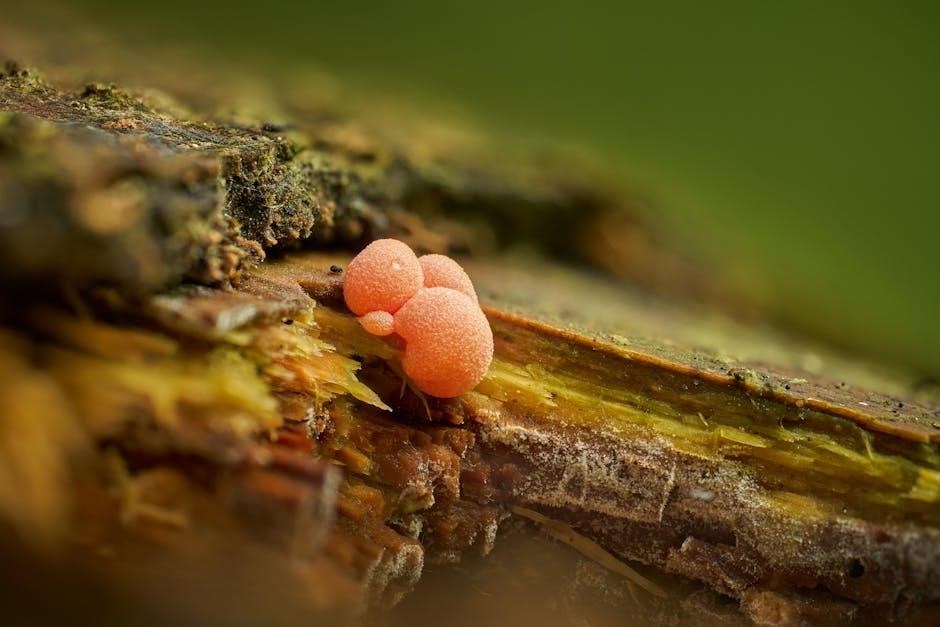Essentials of Biology by Sylvia S. Mader is a foundational textbook designed for non-major students, blending clear writing with engaging visuals and interactive tools to explore life’s core concepts.
1.1 Definition and Scope of Biology
Biology is the scientific study of living organisms, focusing on their structure, function, growth, evolution, distribution, and taxonomy. It examines life at various levels, from molecules to ecosystems, exploring fundamental processes like reproduction, metabolism, and heredity. The scope of biology is vast, encompassing fields such as botany, zoology, genetics, ecology, and microbiology. By understanding life’s diversity and complexity, biology provides insights into ecosystems, human health, and conservation. This discipline fosters critical thinking and problem-solving skills, enabling us to address global challenges like disease, environmental degradation, and food security.
1.2 Importance of Studying Biology
Biology is crucial for understanding life and addressing real-world challenges. It provides insights into human health, enabling advancements in medicine, genetics, and disease prevention. Studying biology fosters appreciation for ecosystems, promoting conservation and sustainable practices. It equips students with critical thinking and scientific literacy, essential for informed decision-making. Biology also underpins agriculture, biotechnology, and environmental science, driving innovation and economic growth. By exploring life’s complexities, it inspires curiosity and prepares individuals to contribute to global issues like climate change and food security, making it a vital discipline for society’s progress.

Key Concepts in Biology
Essentials of Biology covers core concepts like cell structure, genetics, and evolution, providing a foundation for understanding life’s complexity and the interconnectedness of ecosystems and biodiversity.
2.1 Cell Structure and Function

Cell structure and function form the foundation of biological studies, exploring the components essential for life. The cell membrane regulates material exchange, while the cytoplasm serves as the medium for metabolic processes. The nucleus houses genetic material, and mitochondria generate energy through cellular respiration. Ribosomes synthesize proteins, vital for cellular functions and overall organism health. Understanding these structures and their roles is crucial for grasping biological processes, from reproduction to metabolism. This section delves into the intricate mechanisms that sustain life at the cellular level, providing a comprehensive overview of how cells operate and interact within organisms.
2.2 Genetics and Heredity
Genetics and heredity focus on how traits are passed from one generation to the next. The discovery of DNA as the genetic material and the principles of Mendelian inheritance form the basis of this field. Genes, segments of DNA, carry instructions for traits, and their transmission follows predictable patterns. Modern advancements, such as CRISPR technology, highlight the practical applications of genetic knowledge. Understanding heredity is essential for exploring evolutionary processes, medical diagnostics, and personalized medicine. This section explores the fundamental mechanisms of genetic inheritance and their significance in shaping life’s diversity and complexity, providing insights into the biological and ethical implications of genetic research.
2.3 Evolution and Biodiversity

Evolution and biodiversity are central to understanding life’s diversity and complexity. Evolution explains how species change over time through mechanisms like natural selection, genetic drift, and mutation. Biodiversity refers to the variety of life at genetic, species, and ecosystem levels. It is crucial for maintaining healthy ecosystems, as diverse communities are more resilient to environmental changes. The loss of biodiversity can disrupt ecosystems, affecting nutrient cycles, food webs, and energy flow. Studying evolution and biodiversity helps us appreciate how life adapts and interacts, providing insights into conservation and sustainability efforts. This section explores these concepts, highlighting their relevance to both ecological balance and human well-being.

Biological Processes
Biological processes are essential for sustaining life, including photosynthesis, respiration, and nutrient cycling. These processes convert energy, maintain ecosystems, and ensure the survival of living organisms.
3.1 Photosynthesis and Respiration
Photosynthesis and respiration are vital biological processes that sustain life. Photosynthesis occurs in plants, algae, and some bacteria, converting light energy into chemical energy through chlorophyll, producing glucose and oxygen. Respiration, a catabolic process, breaks down glucose to release energy, forming ATP, with oxygen involved in aerobic respiration to produce carbon dioxide and water. These processes are essential for energy flow in ecosystems and the carbon cycle. They are thoroughly explained in Essentials of Biology PDFs, emphasizing their role in sustaining life and ecological balance.
3.2 Ecosystems and Energy Flow

Ecosystems are communities of organisms interacting with their environment, functioning as unified systems. Energy flows through ecosystems via food chains and webs, starting from producers like plants, which capture sunlight through photosynthesis. Consumers, such as herbivores and carnivores, transfer energy between trophic levels, with a significant portion lost as heat. Decomposers recycle nutrients back into the environment. The carbon cycle illustrates how carbon moves between ecosystems and the atmosphere. These processes are essential for maintaining ecological balance and are comprehensively covered in Essentials of Biology PDFs, emphasizing their critical role in sustaining life and environmental health.

The Essentials of Biology Textbook
Essentials of Biology by Sylvia S. Mader and Michael Windelspecht is a comprehensive textbook for non-majors, offering clear visuals, interactive tools, and multimedia resources to enhance learning, with PDF availability for easy access.
4.1 Overview of the Textbook

Essentials of Biology by Sylvia S. Mader and Michael Windelspecht is a concise, introductory textbook tailored for non-science majors. It provides a clear, engaging exploration of biology’s fundamental concepts, emphasizing biodiversity and real-world applications. The text is supported by vibrant visuals, interactive multimedia, and practical learning tools to enhance student understanding. Designed for one- or two-semester courses, it ensures non-major students gain a solid foundation in biology without overwhelming complexity. The textbook is available in various formats, including print, eBook, and Connect, with online resources to facilitate learning. Its accessible structure and modern approach make it a popular choice for educators and students alike.
4.2 Key Features and Learning Tools
Essentials of Biology offers a range of engaging features to enhance learning. Clear visuals, including diagrams and illustrations, simplify complex concepts, while interactive multimedia elements and Connections boxes link scientific ideas to real-world applications. The textbook incorporates practical tools like chapter outlines, review questions, and hands-on activities to reinforce understanding. Additionally, the accompanying online resources provide simulations, quizzes, and interactive eBooks to cater to diverse learning styles. These tools not only support student engagement but also help learners apply biological principles to everyday life, making the textbook a comprehensive and effective resource for non-major students.

Resources and Supplements
Essentials of Biology is available in PDF format, providing convenient access to its comprehensive content. Supplementary online resources include interactive simulations, quizzes, and multimedia elements to enhance learning.

5.1 Multimedia and Interactive Elements
Essentials of Biology offers a range of multimedia and interactive elements to enrich student learning. These include interactive simulations, gamified eBooks, and online learning tools that engage students with hands-on activities. The textbook integrates multimedia assets, such as videos and animations, to explain complex biological processes in an accessible manner. Connections boxes and interactive diagrams help students link scientific concepts to real-world applications. Additionally, the PDF version of the textbook is enhanced with hyperlinks and embedded media, making it a dynamic resource for both traditional and digital learners. These features collectively create a immersive learning experience, fostering deeper understanding and retention of biological principles.
5.2 Availability of PDF Versions
Essentials of Biology is widely available in PDF format, offering flexibility for students and educators. The seventh edition by Sylvia S. Mader can be downloaded from various sources, including academic platforms and eBookstores. The PDF version retains the textbook’s clear structure, visuals, and interactive elements, ensuring an engaging learning experience. Some versions are optimized for mobile devices, allowing students to study on-the-go. Additionally, websites like Internet Archive and McGraw-Hill provide access to PDFs, some requiring authentication. This accessibility makes Essentials of Biology a convenient resource for non-majors seeking a foundational understanding of biological sciences.

